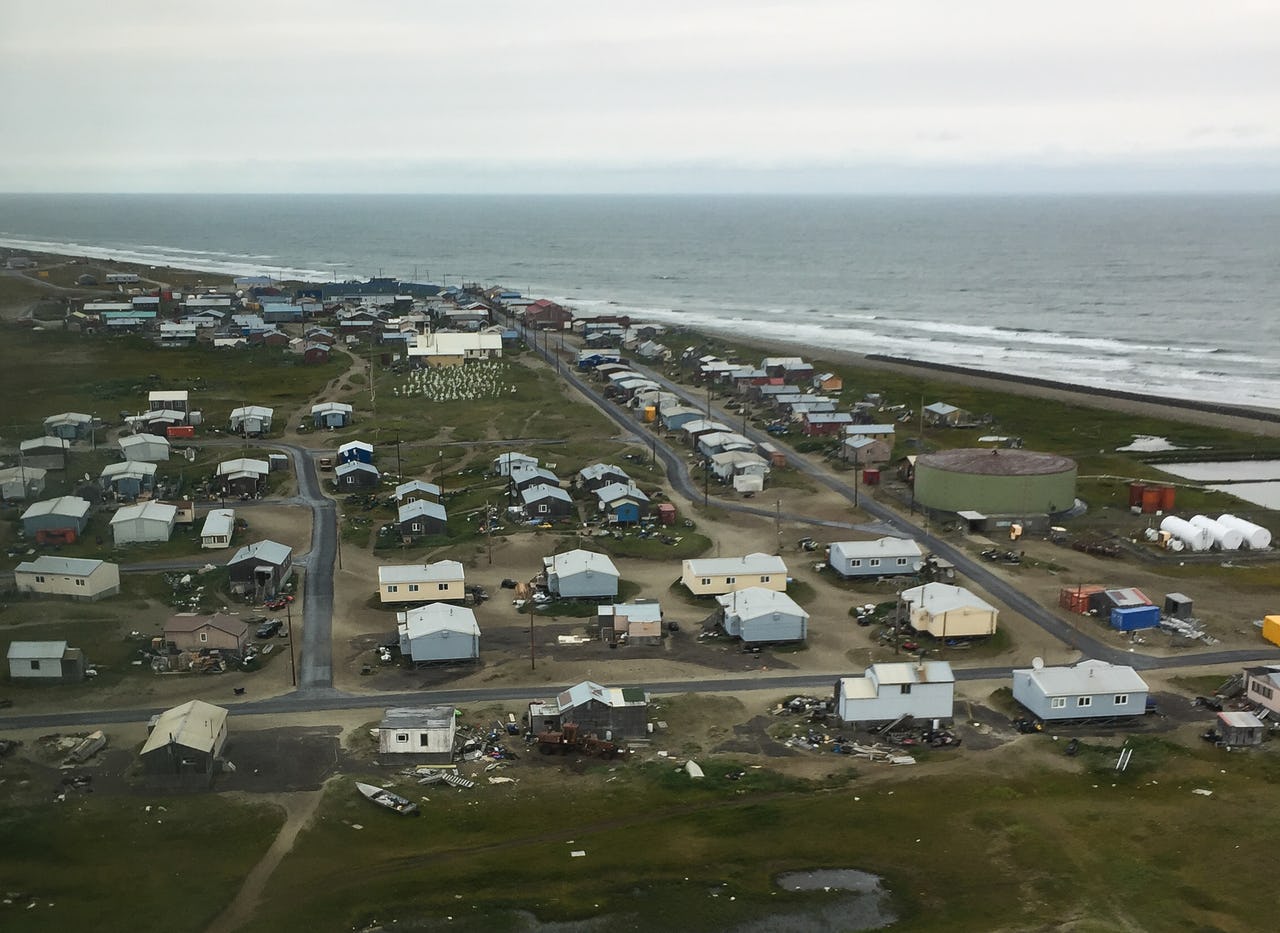Giving a ‘Visual Voice’ to the Changing Arctic Environment

The native village of Shishmaref, viewed from the northeast side of Sarichef Island. Photo: Eli Keene
In a landmark statement, supported by a consensus of well over two thousand scientists, the Intergovernmental Panel on Climate Change asserted that the global average surface temperature rose by approximately one degree F over the past century, and that at the current rate of increase, forecasts indicate that the Earth’s atmosphere will warm by an additional 1.8 to 6.1 degrees by 2100.
Experts in the field have long predicted that the initial and most severe impacts of climate change would occur in the polar regions, which has indeed proven to be the case. Because of its unique physical characteristics, the Arctic is exceptionally vulnerable. The combination of the region’s natural fragility and the indigenous peoples’ dependence on this distinctive environment magnifies the effects.
Over millennia, relying on their traditional knowledge and nomadic lifestyles, indigenous populations in the Far North were able to adapt to gradual environmental changes, sometimes settling briefly in specific territories with more favorable climate conditions and at other times adjusting to subtle shifts in animal migration routes. Today, however, Arctic people cannot easily relocate because an overwhelming majority resides in permanent communities.
There is no denying that the delicate balance has been disturbed. The physical and ecological impacts of a warming climate on Arctic ecosystems are extraordinary, perhaps the most disruptive of all being the thawing of permafrost. Not only is the instability of the substrate affecting wildlife habitat, but it is causing severe damage to buildings, and undermining pipelines and transportation infrastructure. As one example, the hospital in Kotzebue, Alaska, had to be relocated because it was literally sinking into the thawing ground.
Nearly 80% of Alaskan communities, comprised mainly of indigenous people, are severely threatened by climate- and storm-related coastal and river erosion. Estimates are that Shishmaref, a traditional Inupiaq settlement on Sarichef, an island in the Chukchi Sea just north of the Bering Strait, will be consumed by rising seas in the next decade.
The village of Shishmaref is situated on this sand and permafrost barrier island that is approximately four miles long and only ¼ mile wide. The highest point on the island is less than 20 feet above sea level. In recent years, because the sea ice that protected the island from ocean surges in past centuries has deteriorated and even melted completely in some areas, the shore has been receding at an average annual rate of 10 feet, but in the fall of 2001, a severe storm caused the shoreline to move 125 feet inland. The Inupiaq people, who have lived a largely subsistence lifestyle there for 2,000 years are being forced to relocate to higher ground on the mainland at a projected cost of $200 million.
While disputes continue between climate scientists, politicians and the energy sector over methods of analyzing scientific data, visual representation is far more effective at conveying the consequences of climate change to non-scientists. Just as technical graphs and computer models assist professionals in interpreting statistics, it is the empirical evidence in the form of images and recorded personal testimonies that most convincingly builds awareness and enhances the general public’s understanding of the issues.
Moreover, the victims on the front lines of these impacts don’t need to consult scientific papers nor any charts or quantitative data. They witness the realities with their own eyes in their own neighborhoods. In their dramatically-changing surroundings, there are no controversies nor differences in opinion. Anyone who chooses to contest the scientific findings need only look at the photographic proof or listen to the individual accounts of the affected communities. Figures and graphs may offer substantiation, but to the residents whose houses are being washed out to sea, the scientific data is redundant.
Boots-on-the-ground footage, video-taped on-site interviews, and photography are by and large immune to misinterpretation. The following are a few excellent examples of initiatives and projects that serve to educate civil society, industry and policymakers alike in efforts to influence their actions.
The Shishmaref, Alaska, Climate Study Project has installed two network climate stations that collect weather data and webcam images.
Perhaps most sobering of all is “The Last Days of Shishmaref” project that extensively documents the past, present and future of the struggling town’s residents.
Elsewhere, photographer and journalist Gary Braasch’s “World View of Global Warming” aims to ‘make climate change visible.’ His Arctic series can be found here.
On her new initiative’s website, photographer and writer Jenny E. Ross states: ‘Life On Thin Ice leverages the power of photography to communicate accurately and effectively about climate change in the Arctic.’
A more long-term and ongoing effort that began as a photographic assignment for James Balog, is an innovative effort that gives a ‘visual voice’ to our planet’s changing ecosystems. Interestingly, Balog was a global warming skeptic until the time-lapse imagery he collected changed his views so significantly that it became the impetus for his Extreme Ice Survey [EIS] project. An excellent introduction to the mission of EIS is the subject of Balog’s TED presentation.
The ramifications of a warming climate in the Arctic are complex and not yet fully understood, however, there is little doubt that they extend well beyond the immediate region, and are likely to have profound global repercussions. Ultimately, for the people who must contend with the implications on a daily basis, whether climate change is 17% or 87% anthropogenic is inconsequential. What affects their communities most dramatically is the loss of their age-old traditional lifestyle that, along with the animal species on which they rely, is at risk of going extinct. Adapting to impacts as alarming as those occurring in the Arctic today is the biggest challenge northern indigenous people have ever had to endure. Hopefully the aforementioned projects will help spread the word further and wider, and motivate the global community to become wiser and more conscientious stewards of our planet.